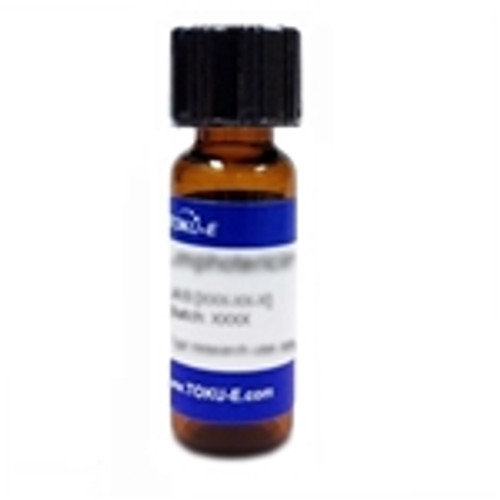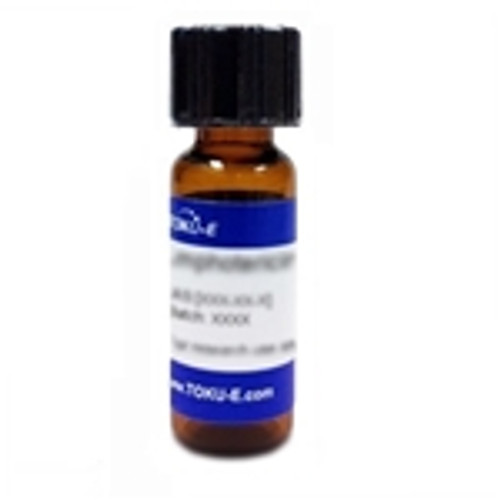Cytochalasin B is one of the most extensively studied members of a family of potent mycotoxins produced by several species of fungi. All members of the class exhibit profound effects on cytoskeletal proteins, giving rise to pronounced morphogenic activity in animals and plants. Despite the common mode of action, there is evidence that individual members of this class display diverse selectivity. However, lack of comparative co-metabolite analysis has restricted a more complete understanding of their individual selectivity. Cytochalasin B is often used in cytological research, micronucleus assays, lucose transporter studies, characterization of actin polymerization, and cytokinesis studies.
Cytochalasin B is soluble in ethanol, methanol, DMF and DMSO.
| Mechanism of Action | Cytochalasin B exhibits potent inhibition of actin filament function leading to cell death by apoptosis, and displays a broad range of cellular actions. It inhibits cytoplasmic division via blocking the formation of contractile microfilaments. |
| Source | Cytochalasin B was first described in 1967 and isolated from moulds (Dr W.B. Turner) and later found to cause cell multinucleation and motility effects. Originally, it was isolated from Helminthosporium dematioideum. Other producers include Phoma spp, Hormiscium spp. Curularia lunata, Drechslera dematoidea and others. It can also be synthesized in the laboratory. |
| Eukaryotic Cell Culture Applications |
It is used in cloning applications. Enucleated recipient cells are treated with Cytochalasin B to make the cytoplasm of the oocytes more fluid thus the nuclar genome can be aspirated within a small vesicle of plasma membrane via micro-needle. Cytochalasin B induces two types of effects on cultured cells which are distinguished acording to concentration or to exposure time. Brief treatment with low dose (<1 μM) resulted in immediate inhibition of membrane ruffling and cell migration but no morphological change, thus it disrupted the microfilament structure but not the sheath structure. However, 10-20 μM resulted in cell morphology change (flat to arborized) and analysis via immunofluorescense with actin antibody showed that the actin cables were dissociated and nuclear rodlets formed (Yahara et al, 1982). |
| Plant Biology Applications | Cytochalasin B can reversibly inhibit light-oriented chloroplast movement. This photoperception is not influenced by this inhibitor. Results support theory that protein fibrils are essential for this intracellular movement (Wagner et al, 1972). It can interact with indole-3-acetic acid (IAA) in wheat coleoptile segments and maize roots, which leads to vesicle transport inhibition and blockage of elongation and growth (Pope et al, 1979). |
| Cancer Applications |
Cytochalasin B was reviewed in tumor cells by BCG (Bacillus Aalmette-Guerin)-activated macrophages and found to enhance tumor cell lysis and statis directly, could be inhibiting the actin filament formation (Martin et al, 1981). Cytochalasin B can induce cell death and growth inhibition in human cancer cells via the blockage of survivin and securin expression. These are proteins that are overexpressed in most cancer cells and regulate mitotic progression. Results indicate the Cytochalasin B, via inhibiting survivin and securin expression, may increase cancer cell death in human lung carcinoma cells lines (Chao and Liu, 2006). |
| References |
Aldridge DC et al (1967) The structures of cytochalasin A and B. J. Chem. Soc. 1667
Martin F, Olsson N and Jeannin Jl (1981) Effects of four agents that modify microtubules and microfilaments (vinblastine, colchicine, lidocaine, and Cytochalasin B) on macrophage-mediated cytotoxicity on tumor cells. Cancer Immunol. Immunother. 10-10 (2-3):113 Pope DG, Thorpe JR, Al-Azzawi MJ and Hall JL et al (199) The effect of Cytochalasin B on the rate of growth and ultrastructure of wheat coleoptile and maize roots. Planta 144(4):373-383 PMID 24407327 Smith GF, Ridler MA, Faunch JA (1967) Action of Cytochalasin B on cultured human lymphocytes. Nature 216 (5120):1134-1135 PMID 6075266 Wagner G, Haupt W, Laux A (1972) Reversible inhibition of chloroplast movement by Cytochalasin B in the green alga Maugeofia. Science 176(4036):808-809 |








